How to Choose an Enterprise Customer Engagement Platform (CEP)
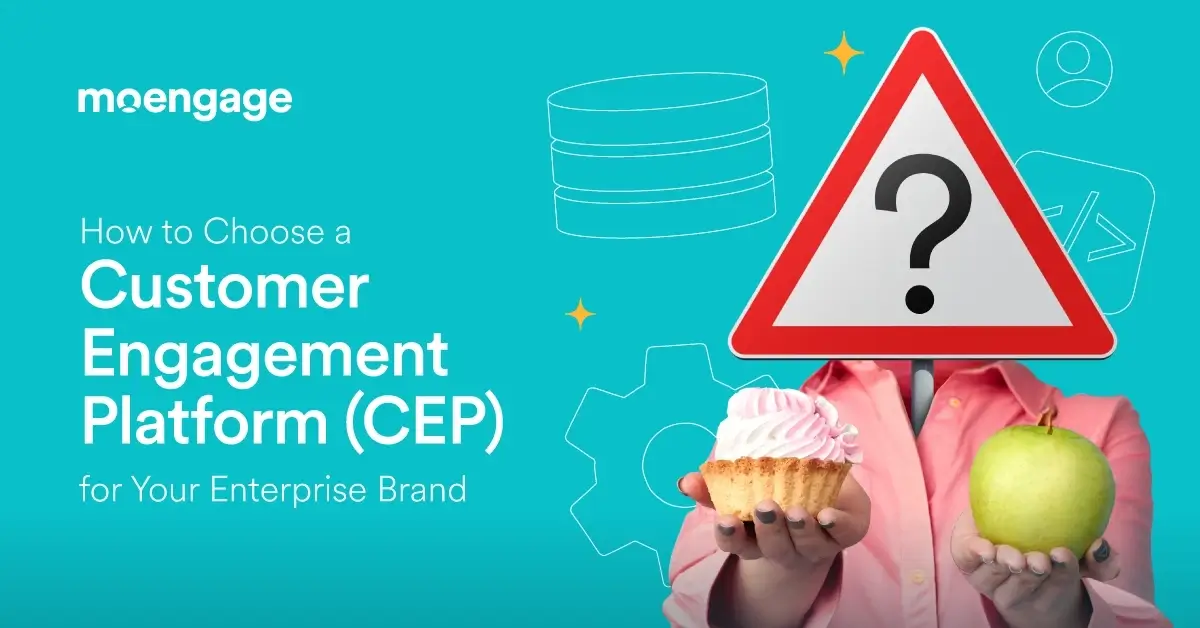
Reading Time: 12 minutes
Choosing the right enterprise Customer Engagement Platform (CEP) can be a daunting task, especially for large companies with complex internal policies, large stores of data, multiple external communication channels, and well-established tech stacks.
But, the fact is, today’s enterprise organizations still struggle to create timely personalized experiences quickly enough to engage and delight customers.
We understand the challenges facing enterprise marketing teams and the difficulties brands may face when solving them. So, we’ve distilled our expertise into a practical, easy-to-understand guide to aid you in your decision-making process.
The ultimate goal?
To help you transform choosing a platform from an overwhelming responsibility into a straightforward (and fun!) assignment.
In this post, we’ll look at how consumer purchasing behavior has shifted in recent years, why customer engagement is critical for growth, and how to effectively select the right CEP for your business.
Let’s dive in.
Why Customer Engagement is Critical for Enterprise Brands
Imagine this: a luxury retailer has invited you to an exclusive fashion show in person just because you looked up their products online.
If this idea sounds far-fetched, think again.
A Sunday edition of the Economic Times recently featured an article highlighting how Luxury retailer Prada onboarded a Customer Engagement Platform to drive personalized communications. But why would a 110-year-old brand with millions of followers and a strong brand presence need to manage customer engagement?
In the last couple of years, there has been a massive shift in customer expectations. Consumers are more digitally connected than ever before. And brands, especially ones in the enterprise space, must adopt a holistic and data-driven approach to customer interactions.
A report from Microsoft concluded that “90% of companies believe their existing systems for analyzing customer journeys need improvement,” which explains why enterprises (especially traditional ones like Prada) are exploring CEP adoption as part of their overarching digital transformation plans.
Here are 4 reasons why customer engagement is so vital in the enterprise.
1. Enhanced Customer Loyalty and Revenue:
Engaged customers are more likely to become loyal and repeat buyers. Since acquiring a new customer can cost five times more than retaining an existing one, nurturing existing relationships is critical.
According to our recent report, 29% of consumers say that the most frustrating thing is when a brand communicates in a generalized fashion or doesn’t remember their preferences based on their previous interactions. On top of that, 56% of consumers say they expect a curated shopping experience from brands they shop from regularly.
According to Bain & Company, brands that excel at customer experience grow revenues 4-8% above the market, indicating the profitability of customer engagement.
Additionally, 80% of consumers are willing to pay more for a better customer experience, underscoring the direct link between engagement quality and revenue potential.
2. Seamless Customer Experiences:
For modern buyers, digital engagement is all the rage. Also, they want brands to be available on their preferred communication channels at their preferred times.
Did you know that 58% of consumers say they interact with a brand at least 2-3 times before making a purchase?
On top of that, over 60% of customers use multiple channels for interaction (including mobile devices) and expect consistent service across these platforms. Enterprises need an omnichannel approach to customer engagement, ensuring consistency across various touch points.
3. Brand Advocacy and Trust:
Creating positive experiences leads to positive word of mouth, which is essential for building extensive brand trust.
Notably, 46% of consumers feel that online business reviews are as trustworthy as personal recommendations from friends or family, highlighting the influence of online engagement and feedback on brand reputation.
Keeping these points in mind, in today’s saturated market, customer engagement can be a key differentiator. With 54% of consumers globally having higher customer service expectations than a year ago, continuously innovating and improving customer engagement strategies is crucial for staying competitive.
4. Reduced Churn and Better Crisis Management:
Finally, regular analysis of engagement helps you to identify and resolve issues.
For example, with the proper processes in place, you can identify dormant accounts or those that are likely to churn and use measures to proactively engage and re-activate them, increasing your chances of generating new sales and preventing customer churn.
Also, in times of crisis or negative publicity, a strong customer engagement strategy can help mitigate damage and maintain customer loyalty.
What is a Customer Engagement Platform (CEP)?
As you can imagine, there are many moving parts to the buyer’s journey and many opportunities to wow customers at each stage. However, doing this at scale requires technology commonly referred to as a CEP.
A Customer Engagement Platform (CEP) is a comprehensive tool that enables businesses to manage, analyze, and enhance interactions with customers across various channels and touch points. It integrates different technologies like marketing automation, customer data analysis, and multi-channel communication to provide a unified view of the customer journey.
This platform helps businesses personalize customer experiences, improve customer service, and foster deeper engagement by leveraging data-driven insights. By doing so, CEPs aim to build stronger relationships, increase customer loyalty, and drive business growth through improved customer interactions.
Based on what we’ve covered so far, it is clear that customer engagement is not just about making sales; it’s about building and maintaining relationships that lead to increased loyalty, revenue, and competitive advantages.
This relationship leads to outcomes like positive word of mouth, valuable insights, and better market positioning.
Now that you’ve bought into this concept, we can shift focus to the “how.”
It’s essential to note though, that “drinking the Kool-aid” and executing a flawless customer engagement strategy are two very separate things.
There’s a lot to think about when moving a large organization in a new direction.
Whether your enterprise has built a customer engagement solution in-house or is planning to make a switch from an existing platform, the process can be time-consuming, demanding a significant investment of resources and careful consideration.
The first step in structuring the criteria for choosing a Customer Engagement Platform is identifying the challenges you’re trying to solve. This will help you in identifying the factors critical to your business. Then, you can begin your search to identify a partner who has solved this challenge for other brands.
High-level market research of analyst reviews such as The Forrester Wave™: Cross-Channel Marketing Hubs Report can be your first litmus test, allowing you to identify the top performers in the martech ecosystem.
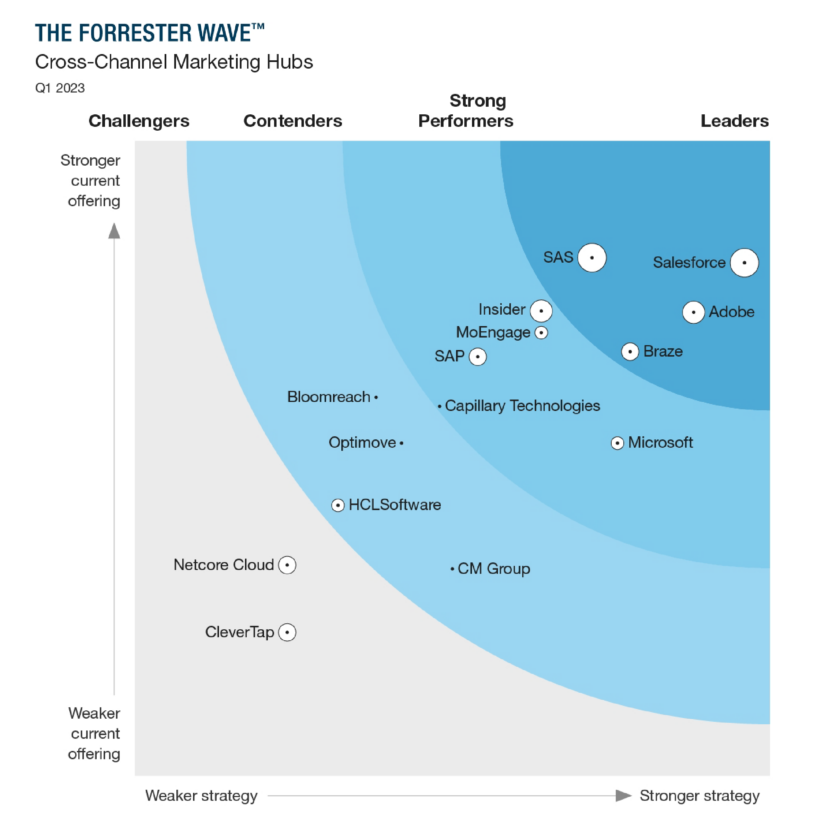
Once you have narrowed it down to a couple of platforms that have the potential to meet your business goals, you can start detailing the criteria you and your team should evaluate through every stage of the buying journey: consideration and evaluation.
With that in mind, let’s review the critical questions you should ask when considering and evaluating CEPs.
4 Questions to Ask When Considering a Customer Engagement Platform:
1. I already have a CRM or a CDP in place. Do I need a CEP also?
Did you know that Customer Relationship Management (CRM) Platforms have been around since the 1980s? And the Customer Data Platform (CDP) category was introduced over a decade ago.
Customer engagement platform vs CRM vs CDP: does the CEP offer you something you don’t already have?
Of course, CRM and CDP technology have evolved since then.
Still, the reality is that to enable your brand to understand what your customers like or dislike, their preferred language, and favorite communication channels, having access to basic customer information is not enough to execute the personalized marketing campaigns expected by modern consumers.
Today’s CRMs and CDPs collect data from multiple sources and unify them into customer profiles. However, they need to send the data to other platforms to convert it into actionable insights.
On the other hand, a CEP acts as a unified platform where your brand can build its marketing automation engine under the same customer data infrastructure, allowing you to not only manage the entire customer journey and lifecycle with a single platform but to also implement robust, highly-tailored and individualized campaigns at scale.
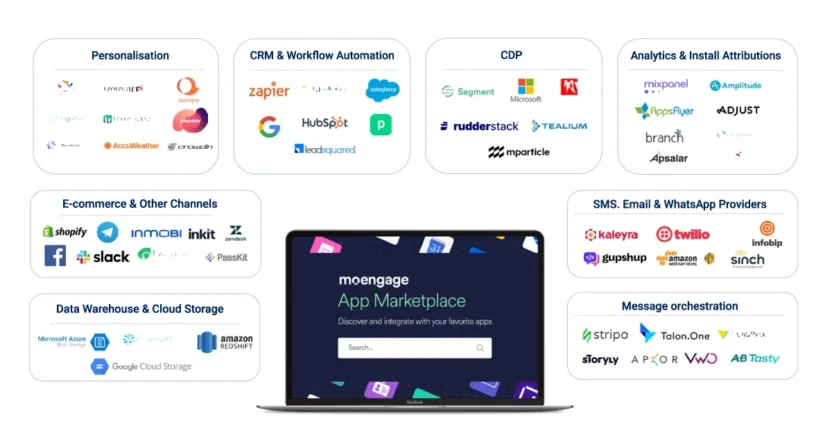
2. Is it the right time to add a CEP to my martech stack?
As B2C organizations mature, they face the dilemma of deciding when to prioritize customer engagement and invest in a Customer Engagement Platform.
If your company is asking this question, it’s critical to pause and compare your current activities to what you want to be doing. This gap analysis will not only help you identify the right CEP, but also give you some insights into how adding another marketing technology can help.
Here are a few signs the time is right to adopt a CEP:
Scaling Challenges:
As the enterprise grows, managing customer interactions across multiple channels manually or with basic tools becomes increasingly challenging. When it becomes difficult to scale customer engagement effectively, an automated Customer Engagement Platform provides the efficiency necessary for an enterprise business.
Inconsistent Customer Experience:
If customers are receiving inconsistent experiences across different channels (like social media, email, and the web app), it’s a sign that a more unified approach is needed. A CEP can help ensure consistent and personalized interactions across all touchpoints.
Difficulty in Leveraging Customer Data:
When an enterprise struggles to gather, analyze, and act upon customer data due to disparate systems, a CEP can provide a centralized platform for data analysis, helping to tailor marketing strategies and improve customer experiences.
Declining Customer Satisfaction or Engagement Metrics:
If there’s a noticeable decline in key performance indicators like customer satisfaction scores, engagement levels, or repeat business, it may be time to invest in a Customer Engagement Platform. This platform can help identify the underlying issues and improve engagement strategies.
3. Build or buy – which option is best for my brand?
The “buy vs. build” conundrum remains an age-old issue whenever businesses plan to add to or upgrade their martech stack.
While it must be judged on a case-by-case basis, building something as complex and intricate as a CEP will require time, resources, and, most importantly… money.
Building a Customer Engagement Platform is not a set-it-and-forget-it activity.
Customer engagement is a dynamic process. With consistently shifting channel preferences and purchasing behavior, enterprise brands need to ensure that they can keep up with these trends. This means constantly innovating and adding new capabilities to the CEP, which can be quite resource-intensive in the long run.
And that’s not all.
When building an internal platform, there is always the potential for unexpected points of failure that could be expensive to diagnose and navigate. So, it’s important to look beyond the surface and consider the implicit costs that could be encountered during or after the build phase.
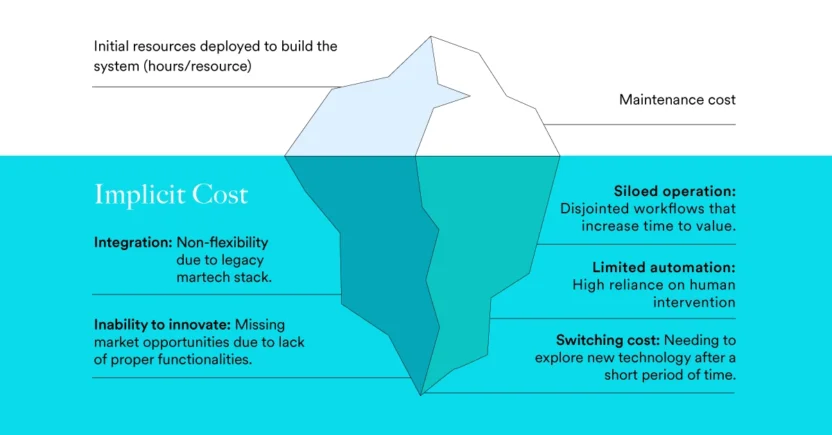
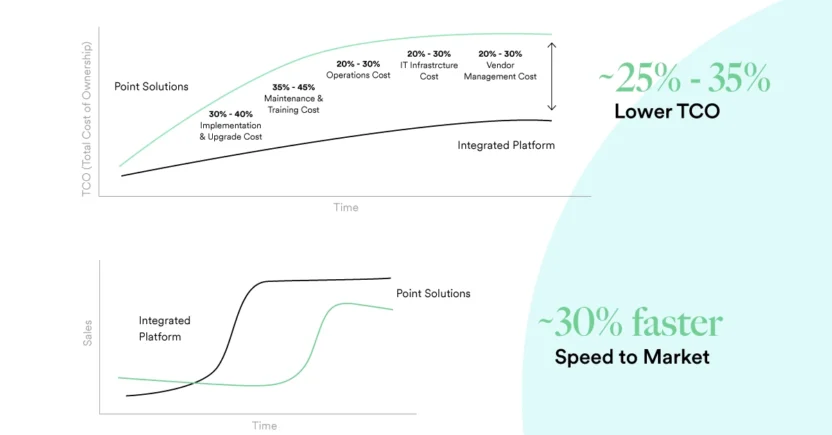
4. Will integration and migration be a challenge?
The last step in the consideration phase is assessing how smooth the implementation and migration process will be.
Implementing a platform into an organization is a complex process and requires participation from multiple stakeholders, prior assessment of business objectives, budgets, limitations, benefits, and more.
It involves critical assessments, and some hurdles you should be cognizant of are:
- Data Security: It’s essential to ensure the provider has robust security measures in place.
- Data Migration: Transferring data from an existing system to a new CEP platform can be complex, especially when dealing with large volumes of data or unstructured data.
- Integration: Integrating the Customer Engagement Platform with existing on-premises systems can be challenging, particularly if application programming interfaces (APIs) or other integration tools are not readily available.
- Customization: Customization can be difficult if the organization has unique or complex needs.
- Change Management: As with any new technology, employee resistance can cause issues and limit adoption.
To overcome challenges when adopting a new platform within your enterprise organization:
- Conduct a thorough review of the provider’s security protocols alongside continuous internal cybersecurity updates.
- Maintain open communication to address concerns and provide technical support for any issues.
- Prioritize education and training for all team members, along with data democratization
3 Questions to Ask While Evaluating a Customer Engagement Platform:
1. What core capabilities do I need?
Once you have considered all the possible scenarios, it’s time to evaluate some of the core capabilities a CEP can offer and what suits your needs best.
To get started, here are the basic functions that every Customer Engagement Platform needs to have:
- Storage repository to store and process data.
- Data orchestration engine to set workflows to process, transform, and route data.
- Attribution and segmentation engine to transform data into actionable insights.
- Integration layer to plug in files and APIs.
- User-friendly interface for stakeholders.
- Business intelligence and analytics capabilities to visualize data assets created within the platform.
- User identity creation by mapping a 360-degree profile view of the customer.
- Ability to comply with internal and external data governance and privacy policies.
2. Does it fit with my current enterprise martech stack?
A key point of contention for many enterprise marketers when purchasing new software is figuring out if and how to integrate it with the current systems already in place. If the new solution doesn’t play well within the current martech landscape, you can bet that it will be difficult to convince others to purchase it, let alone use it.
Before going too far into the evaluation phase with any vendor, here is a framework for understanding how a new tool or platform might fit in with your current enterprise martech stack:
Step 1: Assess Your Current Technology Stack: Start by thoroughly understanding your existing technology infrastructure. Identify the tools and systems already in place, their functionalities, and any gaps or pain points.
Step 2: Define Your Requirements: Clearly define what you need from the new marketing solution. This includes identifying the specific features, integration capabilities, and scalability requirements that align with your business goals and current technology setup.
Step 3: Check for Compatibility: Evaluate the new marketing solution for compatibility with your existing stack. This involves ensuring it can seamlessly integrate with your current systems, such as CRM, data analytics tools, and other marketing software.
Step 4: Vendor Evaluation and Selection: When choosing a vendor, consider their reputation, support services, and the flexibility of their software. Look for vendors with experience in integrating their solutions into similar technology environments.
Step 5: Request Demonstrations and Trials: Before deciding, request demos and trials to see how the solution works in real-time and assess its integration capabilities with your existing systems.
Step 6: Consult with IT and End-Users: Involve your IT team and the end-users of the software in the evaluation process. Their insights can be invaluable in understanding the technical and practical aspects of integrating the new solution.
3. What is the implementation timeline?
Once you have identified the required core capabilities, assessed potential integration issues, and narrowed down your options, it’s important to look at the implementation plan that will be put in place and any barriers that might hinder success.
When assessing a CEP’s implementation process, here are some items to focus on:
Implementation Timeline and Strategy: Assess the proposed roll-out strategy and its timeline. Determine the ideal duration for implementation to ensure minimal disruption to ongoing operations.
Data Import Capabilities: Investigate the types of data imports supported by the platform, such as CSV imports, Data APIs, S3 imports, and SFTP imports. This will impact how easily you can integrate existing data into the new system.
Integration with Third-party Systems: Evaluate the platform’s ability to connect with third-party systems for ingesting customer and behavioral data, including customer preferences, transaction data, and historical customer action data.
Data Ingestion, Storage, and Activation: Understand how the platform ingests, stores, and activates zero- and first-party data to enhance customer engagement. This includes the platform’s capabilities in handling large data sets and its efficiency in data processing.
Data Ingestion Time for Additional Data: Determine the time required to process additional types of data such as product feeds and product catalogs, which is crucial for maintaining up-to-date and relevant customer engagement.
Data Export Features: Assess the platform’s ability to support data export to other systems, including data warehouses. This includes the export of anonymous customer data and the speed at which these exports can be performed.
Training and Support: Look into the different product training options available and ensure they are comprehensive and tailored to different user skill levels.
Customer Support: Confirm the availability of customer support to address post-integration needs and issues, ensuring ongoing assistance and resolution of potential challenges.
How to Implement Enterprise Customer Engagement at Scale with a CEP: Final Thoughts
In today’s fast-paced digital marketplace, where consumer behaviors and expectations constantly evolve, enterprises selling to consumers face the crucial challenge of staying relevant and engaging.
This comprehensive guide has navigated you through the intricacies of choosing the right Customer Engagement Platform (CEP), a pivotal tool in this dynamic landscape.
Key points covered include:
- The significance of customer engagement for boosting loyalty and revenue,
- The necessity of a multifaceted and personalized approach,
- The vital role a CEP plays in orchestrating this complex symphony of customer interactions,
- How a CEP not only complements your existing CRM or CDP but also elevates your marketing efforts by offering a cohesive view of the customer journey.
As you contemplate integrating a Customer Engagement Platform into your technology stack, remember it’s not just about the technology itself. It’s about the value it brings to your customer relationships.
A CEP empowers you to navigate the nuanced terrain of modern consumer engagement with agility and insight, turning every interaction into an opportunity to delight and retain your customers.
Embracing a CEP is a forward-thinking move, aligning with the evolving demands of the digital consumer.
It’s a journey towards more profound customer connections, heightened brand loyalty, and ultimately, sustained business growth.
Want to use the steps outlined in this post? Download your copy of the Customer Engagement Platform Buyer’s Checklist to aid you in your CEP purchasing process. This interactive document contains everything you’ll need to kick off your search:
Ready to take the next step? Schedule your enterprise customer engagement platform demo to get started.















